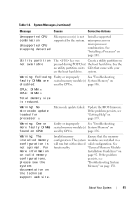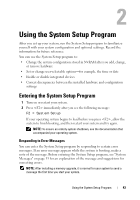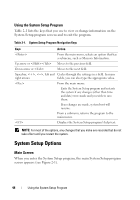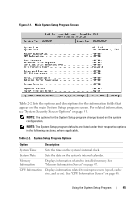Dell PowerEdge R905 Hardware Owner's Manual (PDF) - Page 46
See Serial Communication Screen on See Integrated Devices Screen - manual
 |
View all Dell PowerEdge R905 manuals
Add to My Manuals
Save this manual to your list of manuals |
Page 46 highlights
Table 2-2. System Setup Program Options (continued) Option Description Boot Sequence Determines the order of devices from which the system attempts to boot during system startup. Available options can include a diskette drive, CD drive, hard drives, and network. NOTE: System boot is not supported from an external device attached to a SAS adapter. See support.dell.com for the latest support information about booting from external devices. Hard-Disk Drive Determines the order in which the BIOS will attempt to boot Sequence from hard drives in the system during system startup. USB Flash Drive Emulation Type (Auto default) Determines the emulation type for a USB flash drive. Hard disk allows the USB flash drive to act as a hard drive. Floppy allows the USB flash drive to act as a removable diskette drive. Auto automatically chooses the appropriate emulation type for the device, except for devices installed in the SD card slot. A device installed in the SD card slot will automatically emulate a hard drive. If you install a device in this slot that is configured as a removable diskette drive, you must manually set the emulation type to Floppy. Boot Sequence Retry If this field is enabled and the system has failed to boot, the system will reattempt to boot after 30 seconds. Integrated Devices See "Integrated Devices Screen" on page 49. PCI IRQ Assignment Displays a screen to change the IRQ assigned to each of the integrated devices on the PCI bus, and any installed expansion card that requires an IRQ. Serial Communication (Off default) See "Serial Communication Screen" on page 51. Embedded Server Displays a screen to configure the front-panel LCD options Management and to set a user-defined LCD string. System Security Displays a screen to configure the system password and setup password features. See "System Security Screen" on page 51, "Using the System Password" on page 55, and "Using the Setup Password" on page 57 for more information. 46 Using the System Setup Program















